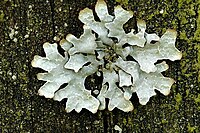
Photo from wikipedia
Phylogenomic datasets continue to enhance our understanding of evolutionary relationships in many lineages of organisms. However, genome-scale data have not been widely implemented in reconstructing relationships in lichenized fungi. Here… Click to show full abstract
Phylogenomic datasets continue to enhance our understanding of evolutionary relationships in many lineages of organisms. However, genome-scale data have not been widely implemented in reconstructing relationships in lichenized fungi. Here we generate a data set comprised of 2556 single-copy protein-coding genes to reconstruct previously unresolved relationships in the most diverse family of lichen-forming fungi, Parmeliaceae. Our sampling included 51 taxa, mainly from the subfamily Parmelioideae, and represented six of the seven previously identified major clades within the family. Our results provided strong support for the monophyly of each of these major clades and most backbone relationships in the topology were recovered with high nodal support based on concatenated dataset and species tree analyses. The alectorioid clade was strongly supported as sister-group to all remaining clades, which were divided into two major sister-groups. In the first major clade the anzioid and usneoid clades formed a strongly supported sister-group relationship with the cetrarioid + hypogymnioid group. The sister-group relationship of Evernia with the cetrarioid clade was also strongly supported, whereas that between the anzioid and usneoid clades needs further investigation. In the second major clade Oropogon and Platismatia were sister to the parmelioid group, while the position of Omphalora was not fully resolved. This study demonstrates the power of genome-scale data sets to resolve long-standing, ambiguous phylogenetic relationships of lichen-forming fungi. Furthermore, the topology inferred in this study will provide a valuable framework for better understanding diversification in the most diverse lineage of lichen-forming fungi, Parmeliaceae.
Journal Title: Fungal Diversity
Year Published: 2018
Link to full text (if available)
Share on Social Media: Sign Up to like & get
recommendations!